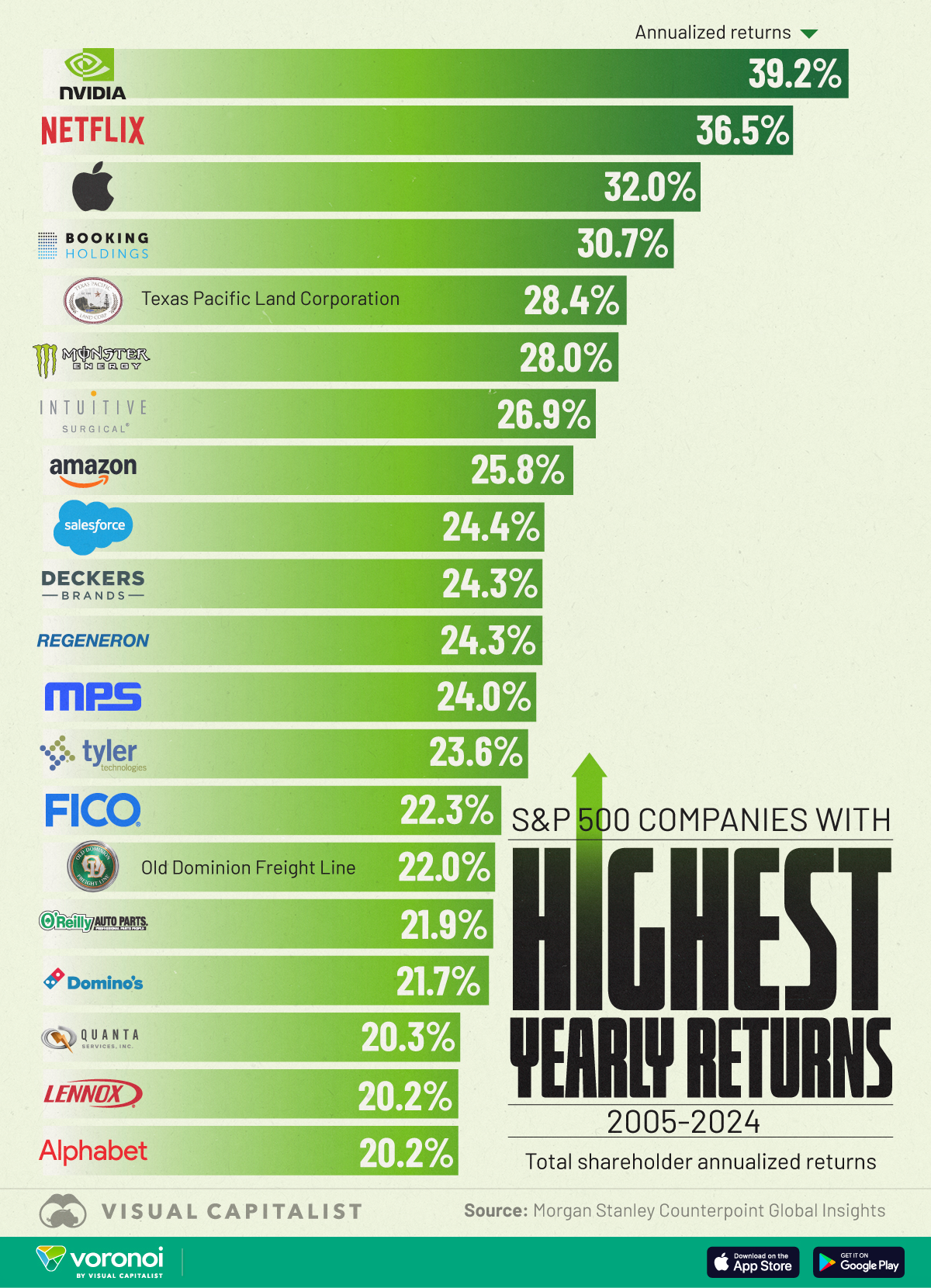![]()
See this visualization first on the Voronoi app.

Use This Visualization
Ranked: The 20 Best-Performing S&P 500 Stocks (2005-2024)
This was originally posted on our Voronoi app. Download the app for free on iOS or Android and discover incredible data-driven charts from a variety of trusted sources.
Over the past two decades, broad-market investors in the S&P 500 have done well, with the index averaging 10.4% annually from 2005 to 2024.
However, a select few companies have outperformed the index, delivering exponential long-term returns—some through steady compounding, others through periods of explosive growth.
This infographic ranks the top 20 best-performing S&P 500 stocks based on annualized total returns (CAGR) over 20 years. The data is from Morgan Stanley’s Counterpoint Global Insights report on probabilities and payoffs, analyzing two decades of U.S. stock performance.
The S&P 500’s Biggest Long-Term Winners
Together, the top 20 stocks have delivered an average annual return of 25.8%—beating the broader S&P 500 index by a large margin.
Topping the list is NVIDIA, with a CAGR of 39.2% from 2005 to 2024. The surge in demand for AI and GPUs has benefited the semiconductor giant, making it one of the world’s largest companies by market cap today.
The table below shows the full ranking of the 20 best performers in the S&P 500 over the last two decades:
| Rank | Company | Annualized Returns (2005-2024) |
|---|---|---|
| 1 | NVIDIA | 39.2% |
| 2 | Netflix | 36.5% |
| 3 | Apple | 32.0% |
| 4 | Booking Holdings | 30.7% |
| 5 | Texas Pacific Land Corporation | 28.4% |
| 6 | Monster Beverage | 28.0% |
| 7 | Intuitive Surgical | 26.9% |
| 8 | Amazon | 25.8% |
| 9 | Salesforce | 24.4% |
| 10 | Deckers Outdoor | 24.3% |
| 11 | Regeneron Pharmaceuticals | 24.3% |
| 12 | Monolithic Power Systems | 24.0% |
| 13 | Tyler Technologies | 23.6% |
| 14 | Fair Isaac Corporation | 22.3% |
| 15 | Old Dominion Freight Line | 22.0% |
| 16 | O'Reilly Automotive | 21.9% |
| 17 | Domino's Pizza | 21.7% |
| 18 | Quanta Services | 20.3% |
| 19 | Lennox International | 20.2% |
| 20 | Alphabet | 20.2% |
| - | S&P 500 | 10.4% |
Netflix and Apple follow NVIDIA closely, along with travel giant Booking Holdings, which owns platforms such as Booking.com and OpenTable. Other tech companies on the list include Amazon, Salesforce, and Alphabet, all delivering more than 20% average annual returns.
Beyond tech, long-term winners include consumer and industrial firms like Monster Beverage, Domino’s Pizza, logistics leader Old Dominion Freight Line, and HVAC specialist Lennox International.
High Reward, High Risk
While long-term shareholders of these companies have grown their wealth, they’ve also experienced some steep drawdowns.
The table below ranks the top 20 best-performing stocks by maximum share price drawdown between 2005 and 2024:
| Rank | Company | Max Drawdown (2005-2024) |
|---|---|---|
| 1 | Domino's Pizza | -92.7% |
| 2 | NVIDIA | -85.5% |
| 3 | Netflix | -82.7% |
| 4 | Fair Isaac Corporation | -79.9% |
| 5 | Deckers Outdoor | -77.6% |
| 6 | Intuitive Surgical | -76.4% |
| 7 | Monolithic Power Systems | -76.1% |
| 8 | Texas Pacific Land Corporation | -74.3% |
| 9 | Salesforce | -72.3% |
| 10 | Quanta Services | -70.2% |
| 11 | Monster Beverage | -70.0% |
| 12 | Booking Holdings | -68.7% |
| 13 | Alphabet | -66.9% |
| 14 | Amazon.com | -65.7% |
| 15 | Apple | -61.5% |
| 16 | Regeneron Pharmaceuticals | -58.9% |
| 17 | Lennox International | -55.0% |
| 18 | Old Dominion Freight Line | -53.9% |
| 19 | Tyler Technologies | -49.6% |
| 20 | O'Reilly Automotive | -48.5% |
Domino’s Pizza has gone deepest in red territory with a 92.7% drawdown during the 2008 financial crisis, where its price fell from $33 to just $3. Top performer NVIDIA is next on the list, and it also accounts for many of the largest single-day market cap losses in history.
Every stock on the list has endured a drawdown of at least around 50% over the last two decades—proving that even the strongest performers carry volatility. The S&P 500 itself saw a 55% decline at its lowest point in this period.
Learn More on the Voronoi App ![]()
Did you know that the U.S. accounts for almost half of the global equity market? Check out All of the World’s Publicly Traded Firms on the Voronoi app to learn more.
The post Ranked: The 20 Best-Performing S&P 500 Stocks (2005-2024) appeared first on Visual Capitalist.